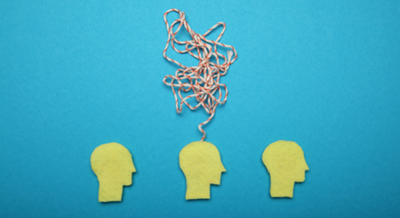
Clinical nurse specialist on our Anxiety Disorders Programme, Frank Smith, shares his expertise on how anxiety can affect us, what conditions are classed as anxiety disorders, and what treatments are available.
We all know what it feels like to be anxious, to be worried about an exam, nervous before a presentation or terrified at the top of a rollercoaster just as it’s about to plummet towards the ground. These are all occasions where it is totally natural to feel a sense of anxiety that soon passes.
There are, however, increasing numbers of individuals reporting levels of anxiety that are disruptive to their day to day lives, often in response to things that may not pose a level of threat to merit the level of anxiety experienced.
In fact, anxiety disorders are the most common mental health difficulties, along with depression, that affect people in Ireland and Europe. It is estimated that one in nine people will go through a primary anxiety disorder at some stage in their lifetime, but only a fraction of these people will receive the appropriate treatment to manage their condition. This is particularly stark given that research consistently demonstrates that, with expert therapy, the majority of people can achieve a lasting improvement.
Tags: OCD Anxiety Social Anxiety Disorder Panic disorder Generalised anxiety disorder CBT Treatment
What is anxiety?
Anxiety is our body’s response to a perceived threat. When we see, hear or smell something we consider dangerous to us in some way, our brain and our body respond, essentially getting us ready for fight or flight'- to fight off danger or to run away from it. Emotional, cognitive and physical changes all happen to prepare us.
One of the key things about anxiety is that it’s the response to a perceived threat, and what we perceive as a threat may not always be an actual threat. An example that illustrates this is the feeling where we’re in the cinema watching a scary movie through our fingers, terrified by events as they’re unfolding before us. There is nothing actually threatening about that scenario, but the story, music and techniques used by the director make us perceive a threat, thereby activating our anxiety response.
Anxiety – on some level – is part of everyday life and can even be beneficial. How do we know when it’s getting to a level where something more serious is happening?
Anxiety is very important: it keeps us safe from threat. It can start to become a problem when our anxiety response gets triggered by things that aren’t as dangerous as we perceive them to be. Equally when our anxiety starts to cause us significant distress or disruption to our everyday lives, this is an indication that it’s becoming a problem.
Most anxiety disorders have their roots in ordinary things that everyone can feel anxious about, but the anxiety becomes amplified and, as a result, is majorly disruptive. People often wonder “did I lock the front door?” after they’ve gone out for the evening. That can be an uncomfortable thought to sit with, but we can often put it out of mind and get on with the evening. For someone living with Obsessive Compulsive Disorder (OCD), they might think that same thought, but drive back 30 miles to check the door, maybe even doing that multiple times just to be sure.
What conditions are classed as anxiety disorders?
-
OCD
OCD is characterised by obsessions, which are unwanted, intrusive thoughts. These thoughts could be about anything from contamination to intrusive thoughts about harm. They are thoughts that can pop in and out of most people’s heads on occasion, but, for people with OCD, they can get very anxious thinking that they may act on these thoughts or that these thoughts mean that they’re in danger. People with OCD then tend to engage in compulsions, which are behaviours intended to neutralise these fears.
-
Social anxiety disorder
Social anxiety disorder is, broadly speaking, a fear of negative judgement by others. Some people may be fine chatting to people, but become very anxious in a one-to-one job interview setting, for example. Other people might be fine dealing with people in work, but really struggle to cope in a casual social interaction. People with social anxiety often fear that they’re coming across as weird or boring; they might worry about going red, sweating or clamming up. In many cases, people will avoid social interactions or rehearse what they might say in certain circumstances in a bid to reduce their anxiety.
-
Panic disorder
Panic disorder is a fear of emotional or physical symptoms of anxiety and so is almost "anxiety about anxiety". People with this condition might, for example, notice that their heart is starting to race; this might lead to a thought that, if they can’t slow their heart, they may have a heart attack. Such a thought will in turn trigger their anxiety response – fight or flight – which will make their heart beat faster, thereby leading to catastrophic thoughts such as “I’m going to have a heart attack; I’m going to die”.
-
Generalised Anxiety Disorder (GAD)
GAD can be characterised to be a range of different anxieties, and people with this condition might be classed as ‘worriers’, tending to see a threat in a lot of different areas. Someone with GAD might plan excessively around a holiday, for example, worrying about things in order to account for every possible negative outcome. The vast majority of these things are hypotheticals and will never happen, but the individual will have expended the nervous energy worrying about them all the same.
-
Other conditions
Other anxiety disorders include agoraphobia, specific phobias (such as heights, illness, or spiders) and Post-Traumatic Stress Disorder.
What treatments are available for anxiety?
The main talking-therapy and gold standard treatment for anxiety disorders is Cognitive Behavioural Therapy (CBT), which essentially tries to rewire how we think about the things that cause us to feel threatened. It’s those thoughts that tend to cause most of the problems for people living with anxiety disorders and the CBT model provides us with a few different ways of working that help us to challenge those thoughts.
CBT in action
If I’m afraid of dogs and I come out of the house in the morning and see my neighbour’s dog there, my anxiety will go up. I’ll think “oh no, he might bite me”, so I might cross the road to avoid him. That may allow me to get on with my day: I won’t feel anxious because I’m away from the perceived threat, but the idea that the dog is going to bite me is going to stay rooted in place.
In this instance, we might challenge the thought through some exposure work. Rather than crossing the road, the CBT therapist would encourage me to walk past the dog; take the risk. Obviously, my anxiety will go up, but, when I inevitably make it past the gentle dog without being bitten, that’s one less thing for my anxiety to hold on to.
Exposure work is a mainstay of treating anxiety disorders and it’s about giving ourselves the chance to learn that the things we’re afraid of aren’t perhaps as dangerous as we think they are. To do that, we need to go into the situation that’s causing us our anxiety and we need to be in there to learn that.
Success of treatment
People will often still be anxious about the things they were anxious about before, but will be usually far more able to deal with them and tolerate them in a day-to-day setting. We try to equip people with the techniques that get them to a place where they can be their own therapist as it were, continuing to do the exposure work and to benefit from it.



